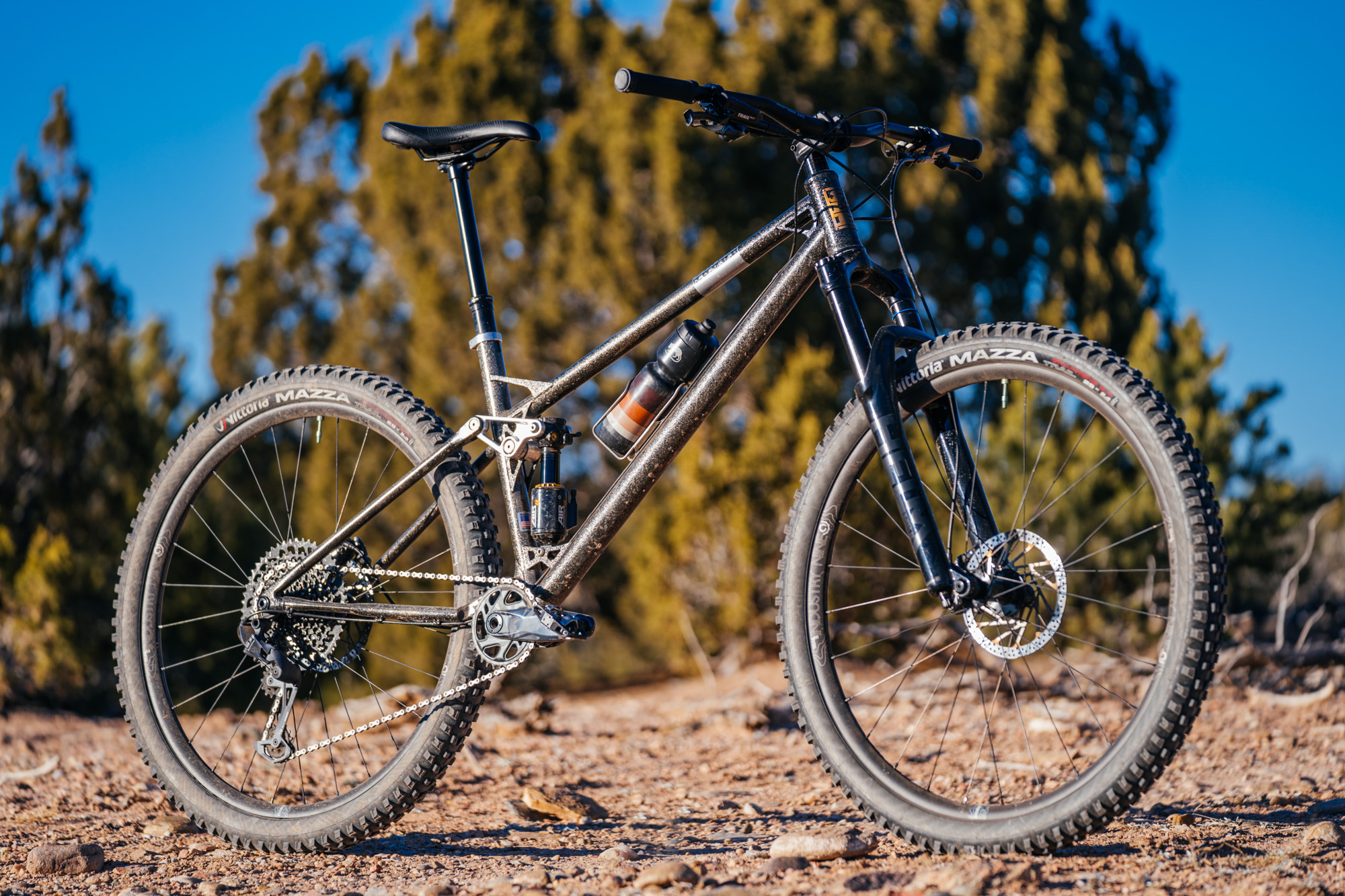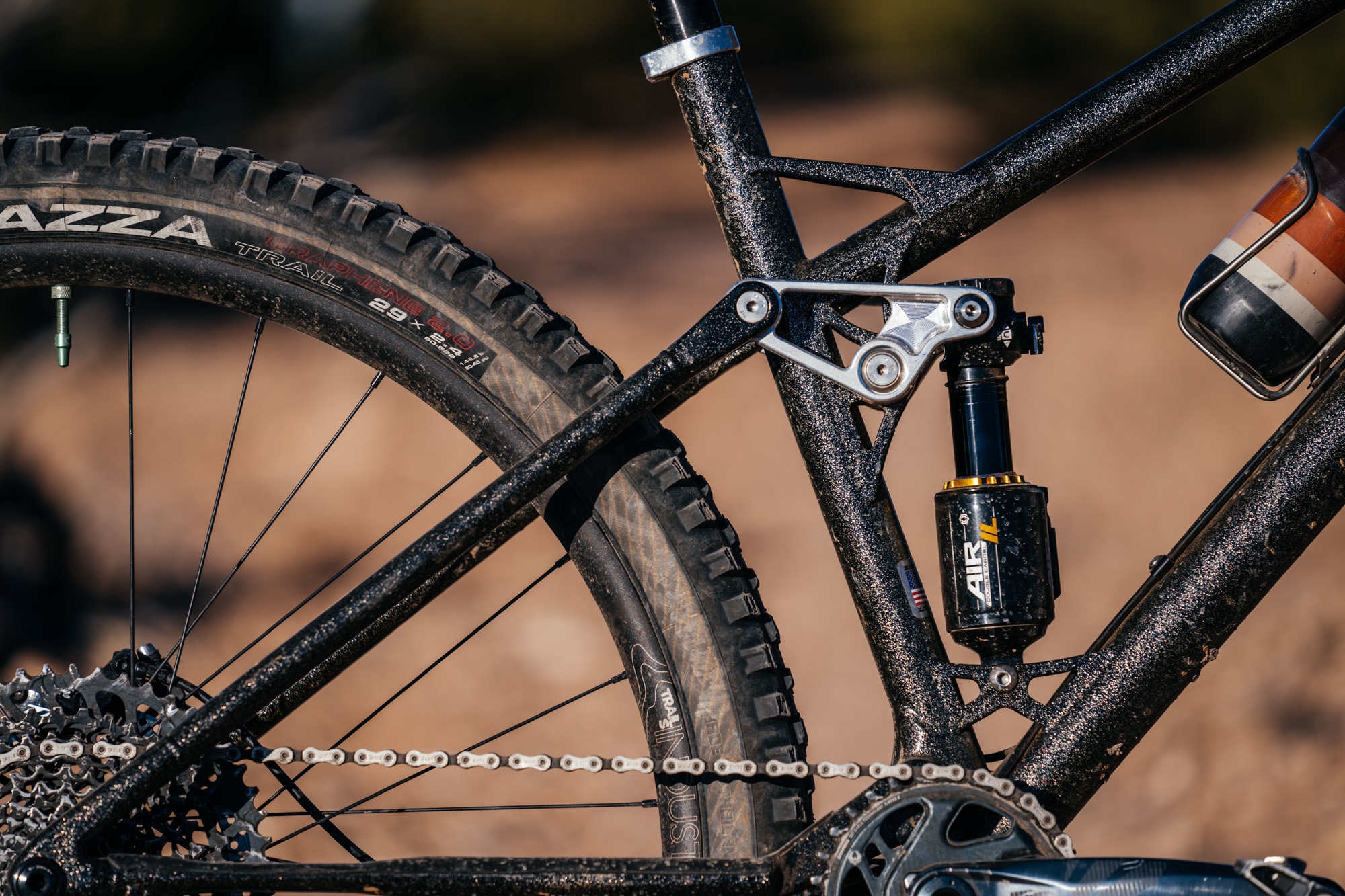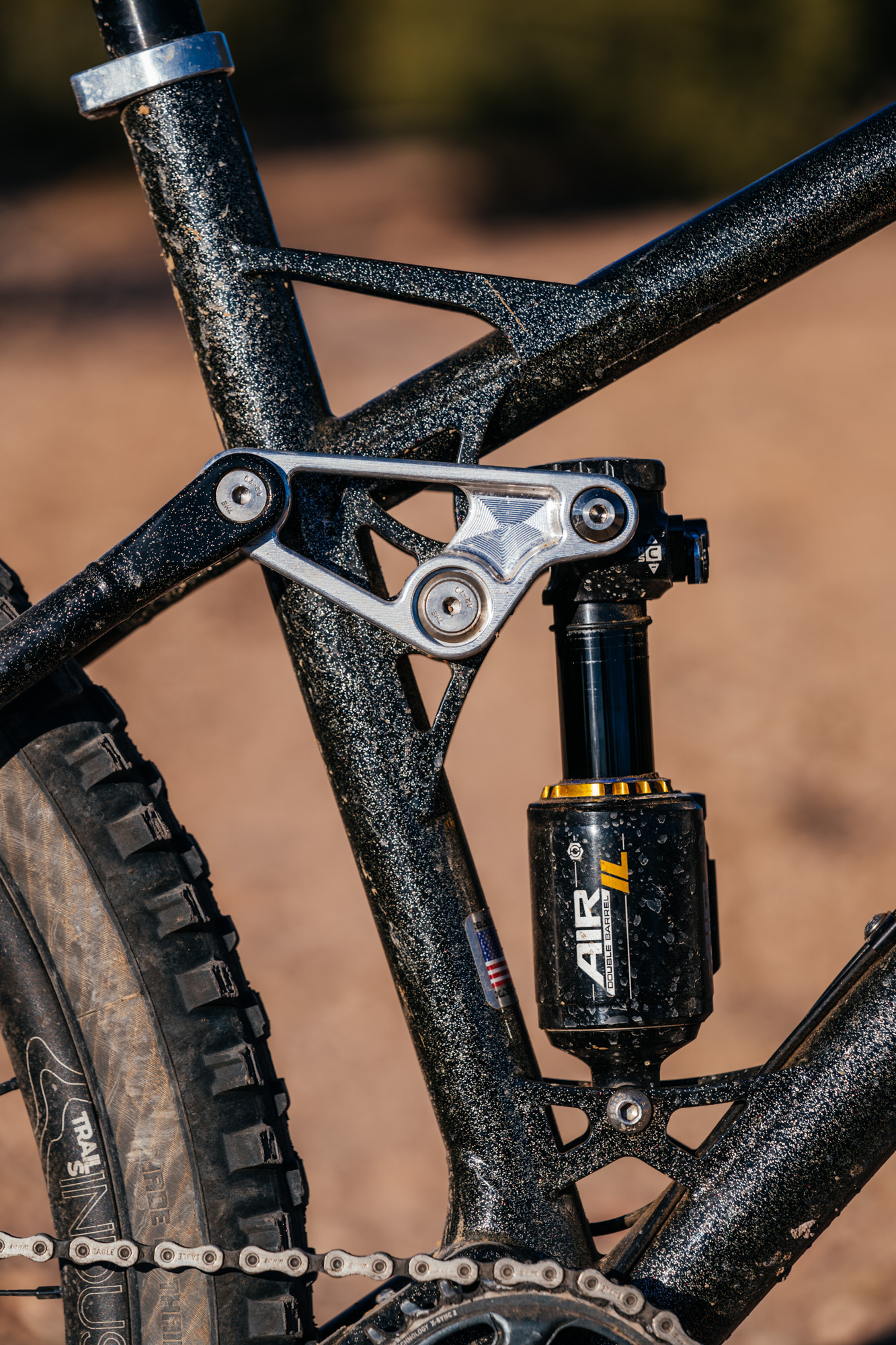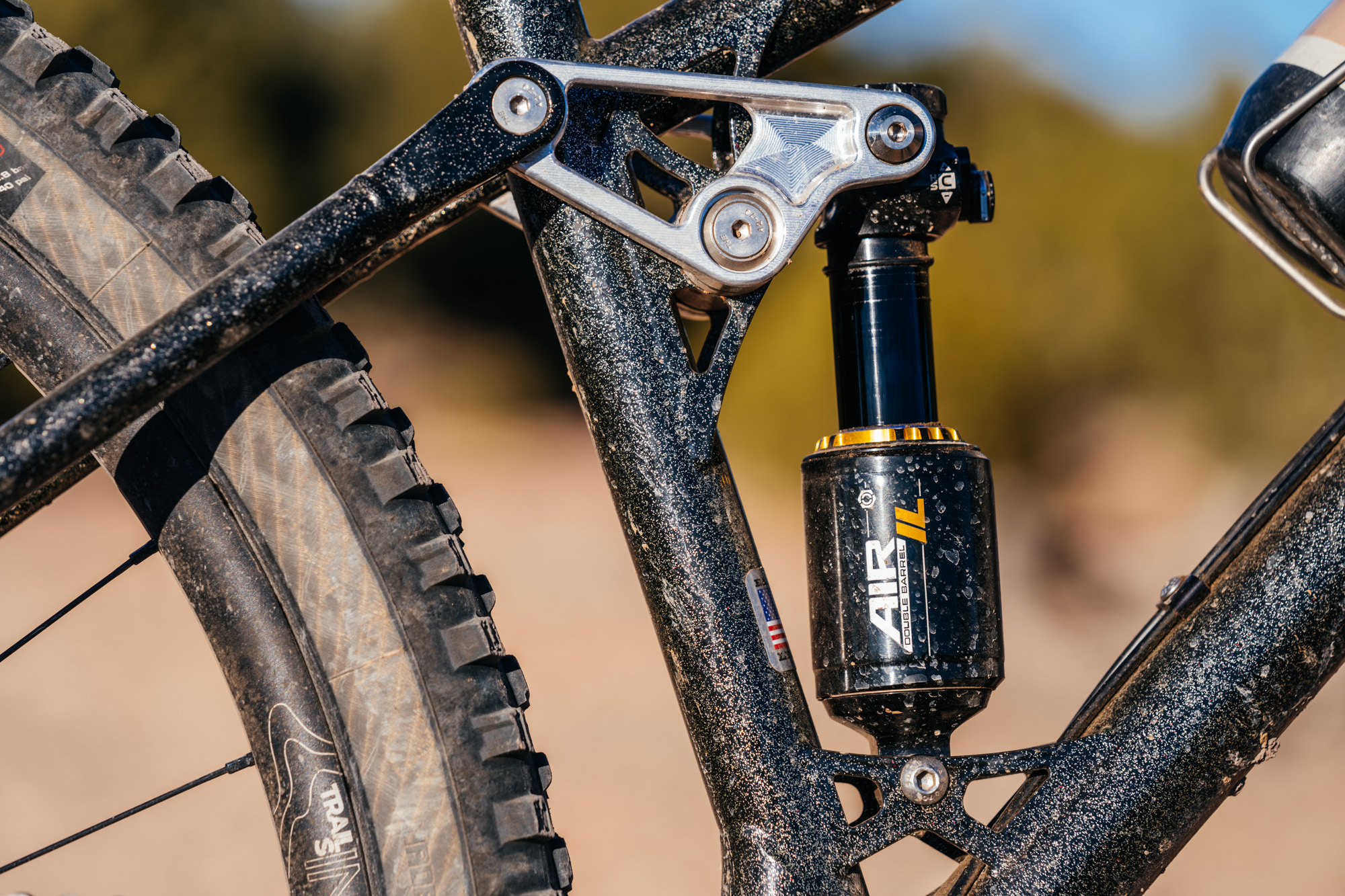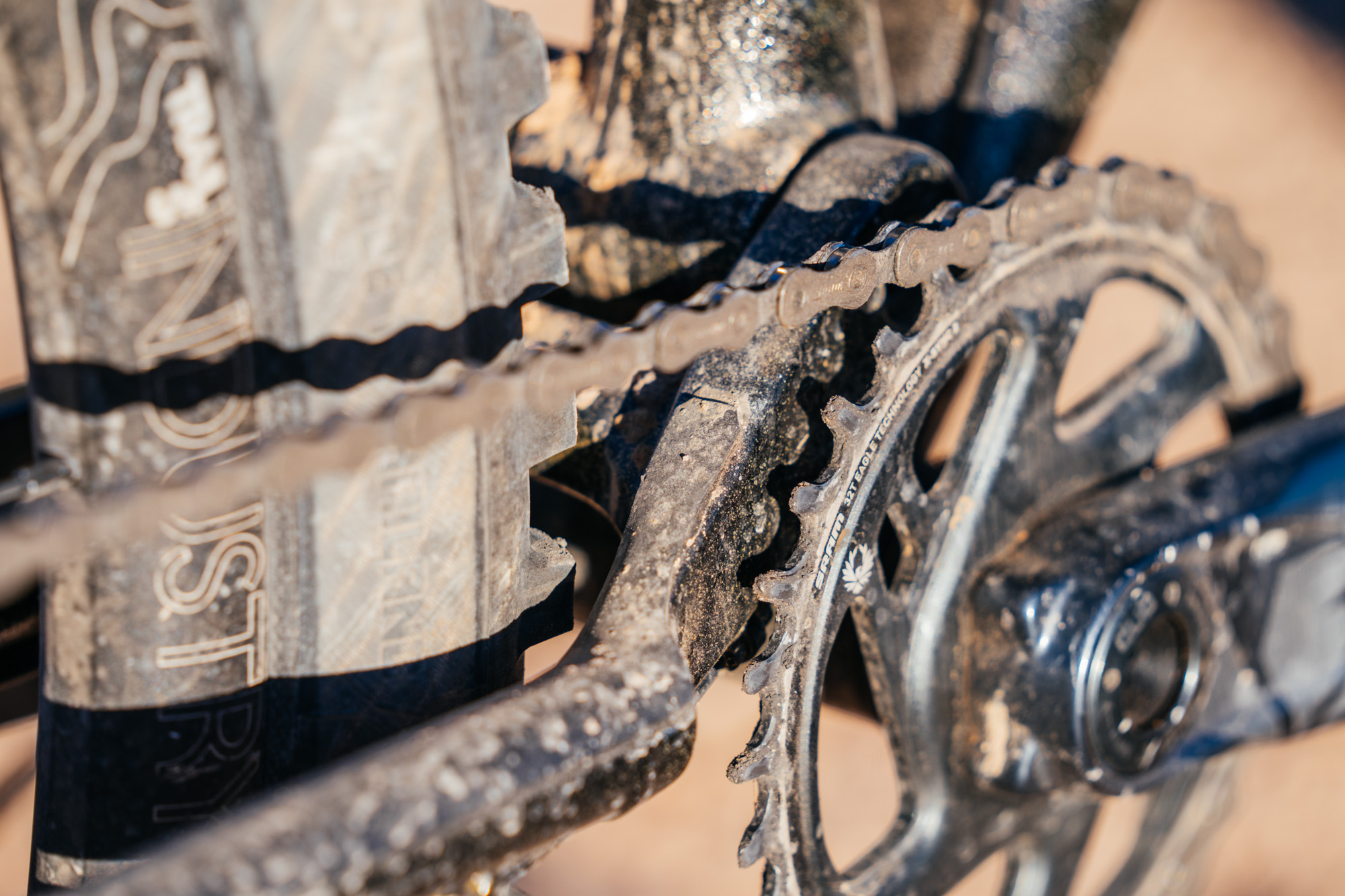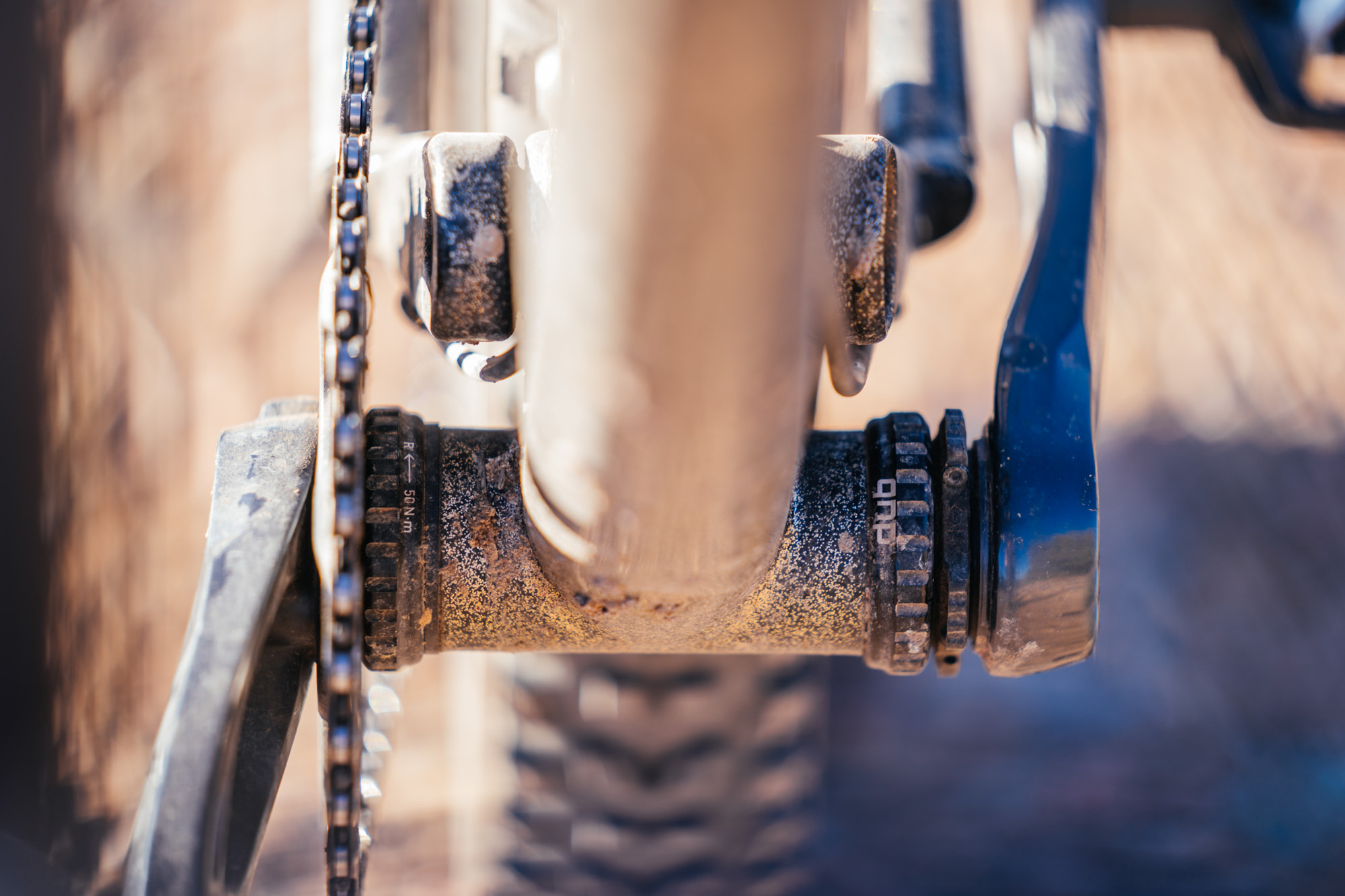While steel full-suspension bikes are nothing new, there has been a resurgence in recent years with many small framebuilders making trail-ready, competent bikes that leave their genetic predecessors in the proverbial dust. When I first rode a Starling Murmur in 2019, I wasn’t prepared for how engaged I felt with the trail or the flex and movement the Murmur provided. If you like the feel of steel hardtails or gravel bikes, chances are you’ll vibe more with a steel full-suspension than a carbon model.
These bikes are incredibly niche (though you can find them being made in workshops worldwide), and they still feel like a product from a cottage industry, not an engineered machine. It wasn’t until I spent some time with the REEB Cycles SST that I felt like steel full suspension bikes had finally leaped into the next stage of their evolutionary process. Let’s take a look at the SST below.

Announced in 2022, the SST joins the REEB lineup as a shorter travel kin to the SQUEEB but before we get into the full review, let’s check out the evolution of steel full-suspension mountain bikes…

An Introduction to Steel Full Suspension Bikes
Back in 1982, Brian Skinner conceived the MCR Descender. Skinner rode motocross and knew that active suspension was the key to improving off-road performance when it came to these new fandangled mountain bikes. The MCR Descender he designed is credited as the world’s first rear-suspension mountain bike and entered the world long before telescopic suspension forks for bicycles were invented, so it used a traditional rigid steel fork. If it looks a little funky to you, that’s because Skinner tried to augment the suspension with a “mullet” set-up using mixed wheel sizes.
The larger 26” front would help absorb bumps, roll over rough terrain, and activate the suspension, while the smaller 24” rear wheel would be stiffer to handle extra load from the suspension and afford more room for the linkage.


It wasn’t until almost a decade later that the first proper “full suspension” mountain bike left the shop of Doug Bradbury in 1991 under the banner “Manitou.” Manitou would become synonymous with mountain bike suspension design with many forks circulating through the fledgling market and ultimately pushing the sport towards the modern designs we’re all familiar with today. Throughout the 1990s, World Cup racing pushed the sport and—let’s be honest— things got a little weird for a while. Into the 2000s steel was replaced largely by aluminum and more full suspensions were produced. This progression led to carbon models and here we are today, inundated by plastic motorcycles.
If you want to read more about this granular nerdery, check out Bruce’s excellent synopsis at The Pro’s Closet Magazine.

Lighter Than You’d Think
The first Starling Murmur I reviewed was a size large built with components on the lighter end of the scales. The 160/140 bike weighed in at 31lbs on the nose. Later, my personal XL model was built up with a more robust trail kit and tipped a little heavier at 35lbs. That’s for a 160mm front travel, 140mm rear travel, enduro bike with CushCore. Pick any comparable model out of a catalog from any carbon manufacturer and it’ll build up around the same weight. So why is there a stigma that steel bikes are tanks?
Well, for a few reasons. First of which is all steel bikes produced overseas in Taiwan or China have to pass consumer safety testing in the States. If a particular bike is designed for “off-road” or “all-terrain” riding, then it has to pass mountain bike safety regulations. That means your gravel bike has been rigorously tested to withstand front-end impacts traditionally endured by mountain bikes. It’s why your steel gravel bike from any of the major brands will probably float around the 30lbs zone with a steel fork (which also has to pass those same tests) and offers a great explanation for the proliferation of carbon forks which can shave pounds off a build.
Yet, framebuilders making their products in the USA, EU, UK, etc, don’t face the same requirements. Some builders offer gusseting to make their bikes more robust and others rely on internal gussets vis-à-vis sleeved tubes or custom drawn butting.
My Murmur has gussets galore, offering a throwback aesthetic to the early days of steel full suspensions. Its phenotype directly relates to the genotype of steel full suspensions. It’s also a big reason why I love the REEB Cycles SST, that sports its own unique gussets… and more.


3D Laser Sintered, Oh My!
REEB has been making mountain bikes and dirt jumpers since 2011, so they know 4130 Chromoly tubing better than most. Nestled between its hardtail models like the Hooptie and fully capable all-mountain downhill bikes like the SQUEEB, the SST is a proper trail bike with a 140mm fork and 120mm rear suspension, delivered by a Trunnion shock.
“A Trunnion mount shock mounts the shock body directly to the linkage – there are two threaded holes on the shock body and linkage bolts thread directly into them. Trunnion mounts have started to become more popular within the last few years with frame manufacturers. A Trunnion mount shortens the overall eye-to-eye length of the shock while allowing it to have the same amount or more, of shock stroke.” – Cane Creek

An upside-down look at the SST’s rocker
What brings the SST to the next level is its 3D laser-sintered technology of various frame components like dropouts, clevises, and more. This culminates in the SST’s CRT Rocker interface with oversized Enduro bearings, making its rear travel predictable and planted, freeing up the front end for playful jibbing and precision-like line finding.


What is Selective Laser Sintering 3D Printing?
Selective laser sintering (SLS) is yet another additive manufacturing technology that uses a high-power laser to sinter, or make a powdered material coalesce into a solid or porous mass by heating the particles of polymer powder into a solid structure based on a 3D CAD/CAM model.
SLS 3D printing has grown in popularity over the past decade as it allows engineers and manufacturers a low cost per part, high productivity procedure for everything from rapid prototyping to small-batch, custom manufacturing. In recent years, several framebuilders have adopted this tech to aid in manufacturing frame parts.


Suspension Design
Suspension design is like a fingerprint for a bike, with many brands firmly planting their flag in one field of engineering. These designs are often licensed, for they hold patents, but every once in a while, a patent expires, offering up smaller companies access to these systems. Horst Link is one such suspension platform, which Specialized leaned on for decades. While the SST combines a single pivot suspension design, it borrows some visual elements of Horst Link.
The SST lacks a rear dropout bearing, allowing the wheel to travel independently of the rear swingarm; REEB engineered the chainstays to be flat, offering a good amount of flex along this same axis. It’s not as pronounced as a traditional Horst Link design, but it’s noticeable compared to more robust and rigid rear swingarms.

The Trunnion shock is where the SST and its CRT Rocker interface absorb 120mm of travel with the bottom of the shock mounted to a bottom bracket cluster gusset and the top of the shock mounting directly to the rocker, allowing the oversized Enduro pivot bearings to take not only the up and down motion but to bear the brunt of any side loading. This design is simple, solid, and would be a cinch to service when the time comes. Replacing two bearings > replacing eight.

SST Specs:
- Frame: $3195 frame only, $6495 GX, or $9895 X01 AXS completes.
- Tubing: REEB designed oversized 4130 Chromoly with custom tube profiles and 3D printed 316L stainless steel components
- Front Suspension: 140mm Fork; 120-150mm compatible depending on the intended use
- Rear Travel: 120mm rear travel
- Headtube: 44mm – ZS44 Top/EC44 Bottom
- BB: 73mm wide English (BSA) threaded BB shell
- Front Hub Spacing: 110 x 15mm
- Rear Hub Spacing: 148x12mm
- Clearance: 29″ x 2.4″ tire
- 160mm Post-mount rear brake (180mm MAX Rotor)
- SRAM UDH hanger (included)
- 173mmx12mmx1.0mm Rear Axle (included)
- Dropper Compatibility: XS-150mm / S-180mm / M-210mm / L and XL-240mm
- Sizing Variations: XS comes 29/27.5 mullet, 130F/120R for super-low standover height and clearance where it matters
- Main Triangle: All sizes fit a water bottle inside the front triangle. Some reservoir shocks may interfere with the bottle on the XS and Small
- 31.6mm ø seat post
- Enduro bearings throughout
- Internal stealth dropper post routing

SST Geometry and Bike Setup
Being 6’2″ with a 36″ inseam and large wingspan, I usually fit right on an x-large frame across the board. I found the 510mm reach on the x-large to be in line with my personal Murmur, so adjusting to the new bike and its idiosyncrasies were simple. Since the SST doesn’t have any flip-chip technology or complicated suspension layout, getting the bike dialed was as simple as setting my saddle height of 80cm and the suspension’s sag at around 25-30%, depending on the riding. I found somewhere around 28% sag was ideal for the sort of rocky riding I do in Santa Fe for the winter months, while closer to 25% worked better down in Southern Arizona on the AZT, which is arguably more cross-country riding. For reference, I weigh around 190 pounds.

Climbing and Descending Vs. Traversing Terrain
Bikes are typically reviewed on a very binary climbing-versus-descending assessment system. However, the beauty of a full-suspension bike lies in its ability to make the constant up/down trails found while traversing a saddle, ridgeline, or relatively flat cross-country terrain. In Santa Fe, we have a good amount of both, but only trails below 9,000′ in the winter months are typically ridable. Unfortunately, I couldn’t take the SST deep into our mountains (which go up to 12,5000′ in our National Forest) because I feel like the higher elevation riding is the actual test of a bike’s abilities.
Still, Atalaya Mountain, and its attendant super steep, rocky terrain, usually offers a great testing ground for such bikes, so I spent most of my time on the SST. The trails are very much within the “sit in and get comfy” category, requiring frequent moments of digging in to keep traction when the grade kicks up.

I never needed to lock out the SST while climbing, as the suspension offers extra traction. Even with the smaller 2.4″ tires (I usually ride a 29×2.6″ on all my mountain bikes), I found the SST sure-footed in the techy climbing bits, rarely losing my tires to slippage. This is partially thanks to the 76º seat tube angle and the 30mm of bottom bracket drop, with the latter only becoming an issue when climbing through fields of baby head rocks. Clipped pedals while climbing are a sacrifice to endure for the sake of a ripping, predictable descent.
You benefit from the tubing’s inherent compliance when climbing a steel bike. Yet it’s when descending that a steel full-suspension bike comes alive. In those high-speed, pinned moments, you feel every nuance of your body’s positioning, where careening through dense trees, loose chunder, or hardpack flow trail aides in a truly zoned-out rider/bike symbiosis. The SST is a master at delivering buttery-smooth riding, yet can course correct when the time comes by a simple shifting of your body weight.
The transitions between lines are where you notice the steel frame’s flex, allowing you to pre-load the frame itself, not just the shocks. Lean far to the right before a left-hand turn, and the frame will snap into position.
I especially admired the SST’s prowess in undulating or traversing terrain. It felt less jarring to do the up/down dance with the Trunnion/pseudo-Horst Link design, which always felt like it was in the right arch of suspension travel at the right time. These transitions were predictable, smooth, and secure, allowing you to push the bike harder into g-outs or sharp, uphill transitions. On one trail in particular, it became a fun game of pre-loading into and out of turns, really upping the maneuverability rating of the SST when compared to stiff carbon bikes that seem to have a mind of their own in the same terrain. The SST dances with you rather than pushing against you, if that makes some sense.

While the suspension design feels more planted with its Trunnion shock and pseudo-Horst Link engineering, especially when compared to a horizontal single pivot design like my Murmur, I still found the SST to be very playful, only requiring a slightly more front-weighted riding position in the steeps than I’m used to. I felt like I had to push my weight into the bike to command its positioning, whereas my Murmur rides like a spring-loaded catapult and is better with my weight, either more central or over the rear of the bike. In the end, the SST feels more planted, less springy, and far less flexy than my Murmur. Yet, it still offers much more frame flex and movement than any carbon bike.
I was amazed at how differently the two bikes rode. Without saying one is better than the other, it’s easy and comfortable for me to say that the SST feels more refined and more engineered than the Murmur. Is that a boon to the SST or a drawback? It’s all preference. Having options in the market will continue to push the evolution of steel full-suspension bikes, and that’s a good thing overall.

Another note I’ll make is that REEB traditionally builds their mountain bikes for park riding: jumps, step-ups, and machine-built, high-speed trails, whereas the Starling Murmur feels more at home on primitive Forest Service singletrack trails (i.e., the Murmur flexes because in older hand-built, mixed-use trails, more of your maneuvering happens at slower-middle speeds in rocky terrain versus the high-speed rollercoaster luge-sensation found in bike parks). Not that you can’t ride a Murmur in a bike park. I have. I just found it to be more fun in chunky, primitive singletrack.
The reasons I love the Murmur on these trails are intertwined with critiques I’ve read about it. Flexy is great for the chunky stuff but not so great when going 35mph down a jump line. The SST feels way more stable at bike park top speeds. Although, if I were as obsessed with steel full-suspension bikes as I am with rigid mountain bikes, I’d quickly throw the money at an SST, as the lower travel numbers feel more aligned with most of my rides and it performs very well in steep and fast terrain.

In Closing
If you prefer the feel of steel when it comes to a hardtail or gravel bike, then there’s no reason you wouldn’t admire its use in a full-suspension package, either. REEB’s SST is the most engineered steel bike I’ve ridden, with several clever design moments, 3D-laser sintered components, and a stout but light-feeling frame. While it is not as flexy as my Starling Murmur, its ride quality is unique in its own right while still savoring steel’s compliance and springy sensation. It climbs sure-footed and descends predictably once you learn how to position your weight in the frame. Even with the 140/120mm travel package as reviewed, I never felt under-gunned or over-gunned in the Southern Rocky Mountains.
Pushing the paradigm of bike design ain’t easy, especially when it comes to steel bikes, but once again, REEB has planted its flag firmly in the chunder and proclaimed they ain’t messin’ around with the SST.

Pros
The frame is stout and well-engineered, with lots of lovely detailing.
Paint job options.
Geometry is progressive, without being too slack and sloppy feeling.
Made in the USA.
Very planted and less catapulty feeling when compared to other single pivot designs.
Cons
The frame is pricey.
Wait times are a bit backlogged due to the SST’s high demand.
2.4″ max tire size is a bit of a bummer.
The build kit, as reviewed, was a bit sluggish, I would love to build with higher-end components and compare, but the review period was very short.
A small front triangle limits frame bag size, cargo, bottle cages, etc.
See more details on the SST at REEB. If you have any questions, drop them in the comments! I’d like to thank REEB for sending me the SST to review, it’s been a true pleasure!



